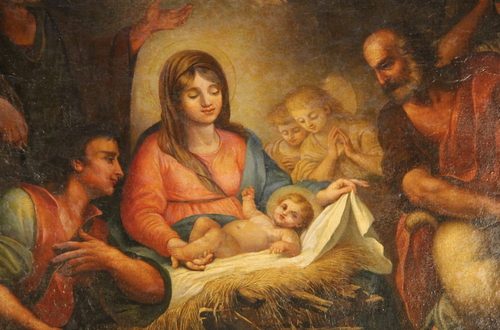The account of Jesus and the woman caught in adultery is well known, but the daughter of my boss sees the story from a different perspective. See what you think.
The account of Jesus and the woman caught in adultery is well known, but the daughter of my boss sees the story from a different perspective. See what you think.
At dawn he appeared again in the temple courts, where all the people gathered around him, and he sat down to teach them. The teachers of the law and the Pharisees brought in a woman caught in adultery. They made her stand before the group and said to Jesus, “Teacher, this woman was caught in the act of adultery. In the Law Moses commanded us to stone such women. Now what do you say?” They were using this question as a trap, in order to have a basis for accusing him.
But Jesus bent down and started to write on the ground with his finger. When they kept on questioning him, he straightened up and said to them, “If any one of you is without sin, let him be the first to throw a stone at her.” Again he stooped down and wrote on the ground. At this, those who heard began to go away one at a time, the older ones first, until only Jesus was left, with the woman still standing there. Jesus straightened up and asked her, “Woman, where are they? Has no one condemned you?”
“No one, sir,” she said.
“Then neither do I condemn you,” Jesus declared. “Go now and leave your life of sin.” (John 8:2–11)
Notice that John makes a point of telling us about Jesus’ physical posture— lots of stooping and standing. Why, one might ask. First we find that the Jewish leaders drag a woman into the temple courts in front of Jesus where a large crowd gathers. We observe that she has been caught in the very act, an act in which one is usually naked. Did they give her time to get dressed? We doubt it. Was part of the humiliation to drag her into public exposed? If so, we may have an explanation for all this stooping and standing, and some insight into the mysterious question: Why did Jesus write on the ground?
John points out that they made her stand before the group. This is another indication that she might have been naked. If she were unclothed, she probably would have wanted to crouch down to cover herself as much as possible. Making her stand—well, you get the picture!
Imagine the gawking crowd! There she is standing naked while the Jewish leaders spout the Mosaic Law to Jesus. Actually the leaders misrepresented Leviticus 20:10 and Deuteronomy 22:22–24, which state that in the case of adultery both the man and the woman must be put to death, but her accusers conveniently neglected to bring him along. They ask Jesus what to do with her, hoping to trap him. If he condemns her, he will lose favor with the people. If he does not, he will be disagreeing with Moses.
Jesus did not respond to their question verbally but instead bent down on the ground and wrote something in the dust with his finger. For centuries, Bible scholars have been trying to guess what he was doing down there. Actually it’s impossible to know for sure—but what if Jesus’ intent was not about what he was writing? What if he was focusing the crowd’s eyes on his hand and off her body?
After writing in the dust, Jesus stood up to face his adversaries: “If any one of you is without sin, let him be the first to throw a stone at her.” Then he stooped down again and moved his finger in the dust . . . eyes focused there one more time, instead of on his sister. The crowd walks away one by one, beginning with her accusers. Finally, when only the two of them are left, he is still stooped, looking down, and she alone is standing in the temple court. Now he stands up and this time he turns to her, and (most likely, in keeping with his character) looks straight into her dazed eyes. Where are they? Has no one condemned you? Then neither do I, but go and leave this life behind. It only leads to humiliation and pain. Free yourself and live worthy of who you are, my sister. He alone was without sin, so he alone could forgive her and release her to a new life of hope and purity.
Sometimes erroneously identified as Mary Magdalene, this woman— whoever she was—represents promiscuous women throughout the ages.We don’t know her specific circumstances. We don’t know if she was looking for love in all the wrong places or if somehow she was coerced. Women without male advocates were often forced into prostitution to live. Others were “bad girls.” We do know that misuse and distortion of God’s beautiful gift of sexuality has been a source of sin and pain for men and women since the fall.
But Jesus refused to take advantage of her sin or misfortune, whichever it was. He did not mock her, laugh at her, or make jokes about her. Instead, he modeled a brother’s love. He set an example of integrity for all of us to follow. He could have seen her as a seductive woman, but he chose to see her first as a person who needed God. He had her best interest at heart. He chose to see her through the eyes of a protective big brother. Neither did he make light of her sin. He instructed her to leave her promiscuous lifestyle and pursue purity and wholeness, commensurate with her identity as a child of the Father.
Did she become his disciple? Odds are she did. Who can resist such love? The gospel attracted women in the early church days. Women flock to Jesus today because of this love, and women will flock to ministries led by men and women who treat one another with this kind of unconditional love and bold instruction. What a beautiful picture of sibling love!
Post Views: 250



2 Comments
Kay S.
Caught in Adultry
Sue, I want to thank you for a beautiful perspective on these well known bible passages! It’s timely for me …. we’ve been studying the book of John in our Sunday School class and spent some reflective and worthy time on these exact verses just recently. I continue to mull over the lessons Jesus gives us in this account of history, and marvel anew everytime He “somehow” brings it back to me — such as times like this when I read your blog post! I want to meet that woman someday in heaven … and I bet you do too! 🙂 Thanks for your good blogaroonie today! God bless you and your day!
Sue Bohlin
LOVE new perspectives!
Wowie zowie! Thanks so much for this, Sue. . . I will never read or think about this passage the same way again. The grace and love of Jesus is SO much bigger than we can apprehend, and your blog post has helped me grow in my understanding of Him.